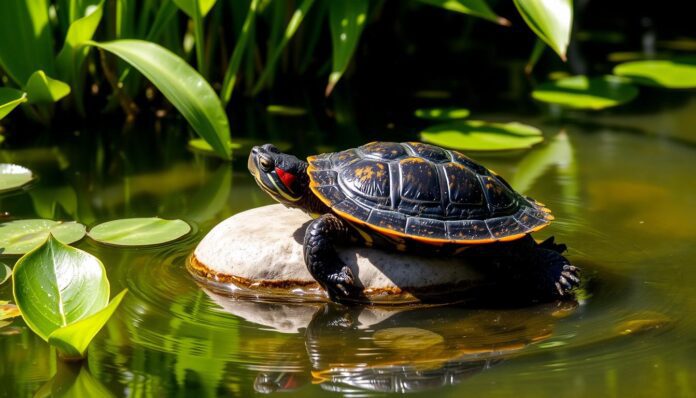Did you know red-eared sliders can grow up to 12 inches long as adults? These turtles are popular pets and found worldwide. This guide will help you care for your red-eared slider, whether you’re new or experienced.
This article covers everything from their habitat to nutrition. Red-eared sliders live 20-30 years, so they need a lot of care. Follow this guide to create a great home for your turtle, ensuring it’s happy and healthy for years.
Understanding Red-Eared Sliders
The red-eared slider, or Trachemys scripta elegans, is a favorite pet freshwater turtle globally. They are known for their red markings behind their eyes. These terrapin species can live in many water environments.
Natural Habitat and Distribution
Red-eared sliders come from the southern United States. They live in ponds, lakes, swamps, and slow rivers. Their range goes from the east to New Mexico and as far north as Illinois.
But, they’ve also been introduced to many other places. This has made them an invasive species in some areas.
Physical Characteristics
These turtles have a smooth, oval shell. It starts bright green in young ones and turns olive or brown in adults. Their skin has green and yellow stripes.
Their underside is bright yellow with dark spots. Adult trachemys scripta elegans can be up to 12 inches long. Females are usually bigger than males.
Lifespan and Growth
In captivity, red-eared sliders can live 20 to 30 years. Some can even live over 40 years. Their life span and size depend on their environment and diet.
Juveniles grow fast, but slow down as they get older. Females tend to grow bigger than males.
Setting Up the Perfect Tank Environment
Creating the right tank setup is key for red-eared sliders’ health. These turtles need big, spacious homes to live well. Adults should have tanks of at least 100 gallons, with 150 gallons or more being best.
For a natural and pretty turtle tank, think about using plastic pond liners or stock tanks. Outdoor ponds are great too, but make sure they’re fenced to keep the turtles in. The aquatic habitat should have both water and land areas for the turtle’s amphibious needs.
| Tank Requirement | Recommended Specification |
|---|---|
| Minimum Tank Size | 100 gallons (379 liters) |
| Ideal Tank Size | 150 gallons (568 liters) or more |
| UVB Lighting | 34″ T5 HO forest UVB bulb |
| Heating Equipment | 2 x 90w PAR38 halogen flood bulbs |
| Water Filtration | Canister filter rated for 400+ gallons |
| Basking Platform | Play sand for shoreline area |
| Water Heater Rating | At least 200 gallons |
To make the perfect tank setup, ensure good water quality, heat, and UVB light. The habitat should look like the turtle’s natural home. Add logs, rocks, and live plants for fun and safety.
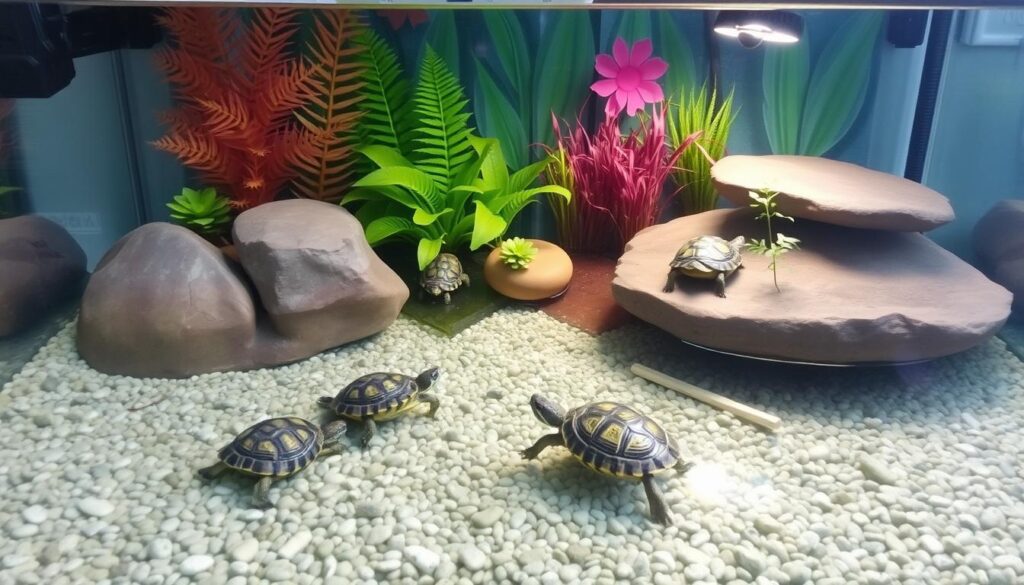
Essential Equipment and Supplies
Proper turtle care needs the right equipment and supplies. This creates a great environment for your pet red-eared slider. Each piece, from filtration systems to heating and lighting, is key to your turtle’s health.
Filtration Systems
Canister filters are best for red-eared slider turtles. They clean the water well by removing waste. A 50- or 75-gallon filter works well for adult turtles.
Heating Equipment
Keeping the water at the right temperature is vital. Use submersible or under-tank heaters to keep it between 72-76°F. Also, a basking area at 90-95°F is needed for digestion and health.
Lighting Requirements
Good lighting, including UVB, is key for red-eared sliders. Hatchlings and young turtles need a 10.0 ReptiSun bulb. Adults do best with a 5.0 ReptiSun bulb. Turn the lights on for 12 hours a day to match their natural cycle.
Other must-haves include thermometers for water and basking areas. These ensure your turtle’s home is perfect for their health. With the right gear, your turtle can live happily in their environment.
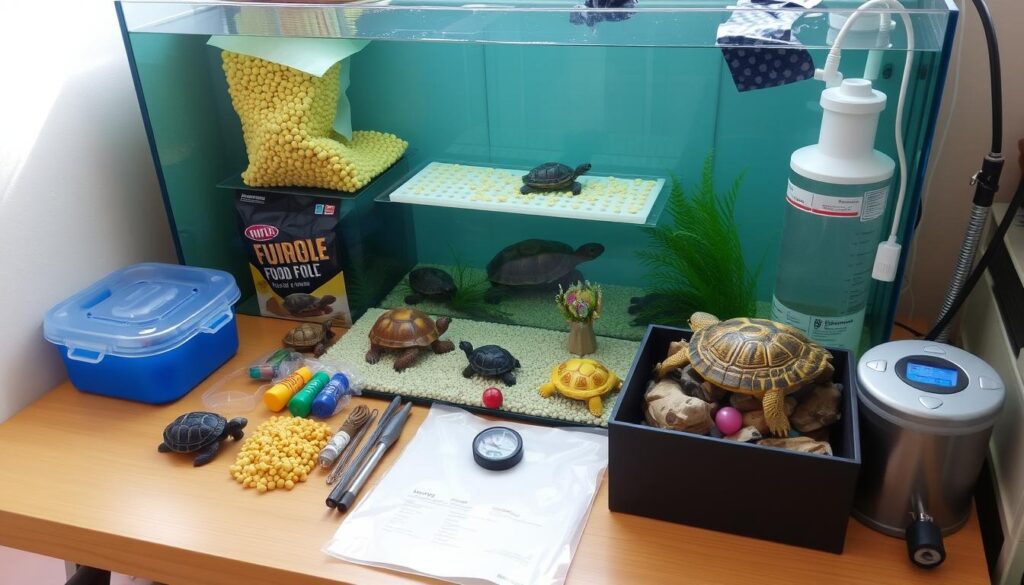
You May Like:- Best Substrate for Leopard Gecko: Complete Guide 2024
Water Quality and Maintenance
Keeping the water clean and healthy is key for aquatic turtles like the red-eared slider. It’s best to change one-third of the water every week. Make sure to use water without chlorine, as it can harm these reptiles.
The tank’s water should be at least twice as deep as the turtle’s shell. It’s better to have a tank with no bottom, making it easier to clean. If you do use a bottom, choose large gravel and an under-gravel filter.
- Do weekly clean-ups by siphoning out debris and scrubbing the substrate every two weeks. This keeps the tank clean.
- Good filtration is vital for keeping the water quality high and preventing health problems in turtles. Choose filters that can handle 2-3 times the tank’s volume.
- It’s important to clean the filter at least once a month. This keeps the water management system working well.
| Water Parameter | Recommended Range |
|---|---|
| pH | 7.4 – 7.8 |
| Nitrates | Less than 80 ppm |
| Carbonate Hardness (KH) | Approximately 80 ppm |
| General Hardness (GH) | 180 – 200 ppm |
| Salinity | 0.4 – 0.5% |
Keeping the water parameters right is vital for aquatic turtles‘ health. Regular water tests and tank cleaning are key. They help prevent harmful substances and keep your red-eared slider happy and healthy.
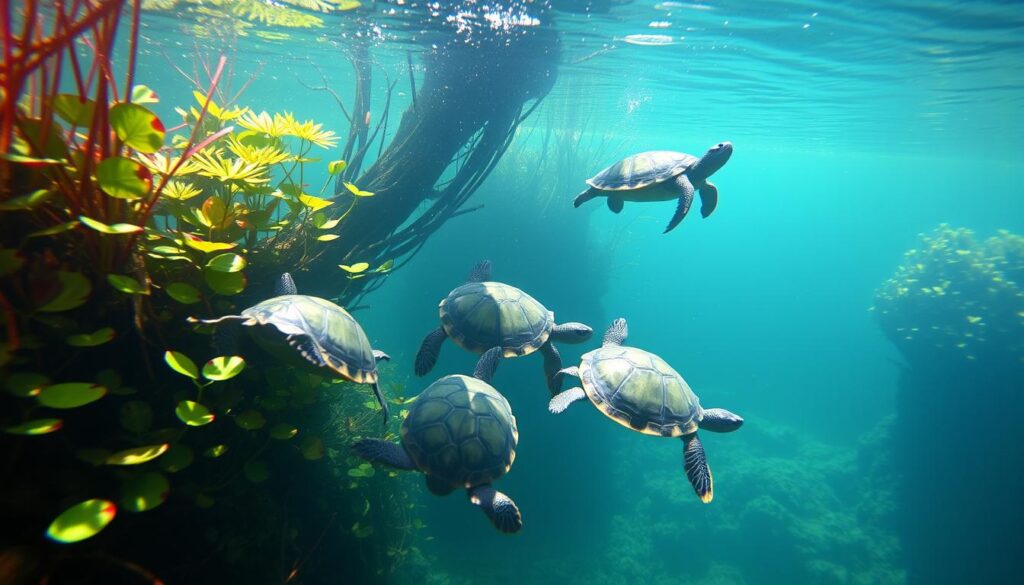
Creating the Ideal Basking Area
Creating a good basking area is key for your red-eared slider’s health. It should be easy to get to, the right temperature, and have the right lighting. This helps your turtle stay healthy and happy.
Temperature Requirements
The basking spot needs a temperature of 90 to 95 degrees Fahrenheit. Turn the heat light on for 10-12 hours a day. Then, turn it off at night so your turtle can sleep.
UVB Lighting Setup
UVB light is vital for your turtle to make vitamin D3. This is important for them to use calcium from their food. Place the UVB bulb within 12 inches of the basking area.
Remember, UVB light can be blocked by some materials. This includes plastic, glass, and tight mesh. Make sure your basking area is clear of these to let your turtle get enough UVB.
Creating a fake shoreline or using an above-tank basking platform is a good idea. Don’t use store-bought platforms as they might be too small or made of bad materials. The platform should be big enough for your turtle to lie on fully out of the water.
If your turtle isn’t basking, even with a good setup, see a vet. They can help find out why.
Nutritional Requirements and Feeding Guidelines
Red-eared sliders are omnivorous reptiles. Their diet includes both plants and animals. Young ones eat more meat, while adults eat more plants. It’s key to give them a balanced diet for their health.
Feeding them a mix of turtle pellets, fresh veggies, and sometimes meat is best. Young ones need food every day. Adults should eat every other day to keep them healthy and the water clean.
- Commercial turtle pellets should make up about 25% of the diet, with the remaining 75% coming from a variety of food items.
- Leafy greens such as collard greens, kale, and bok choy are essential, while iceberg lettuce should be avoided.
- Aquatic plants like anacharis and water hyacinth can be provided as snacks.
- Vegetables like carrots, squash, and green beans can be shredded for smaller turtles.
- Live prey items such as earthworms, crickets, aquatic snails, and shrimp are beneficial for exercise and enrichment.
- Occasional treats like bananas, berries, and melons can be given in small amounts.
- Avoid feeding cooked chicken, lean beef, and processed foods as they can lead to water contamination and health issues.
Watching what your turtle eats is very important. You might need to change their diet to keep them healthy. Talking to a vet can help make a special diet plan. This plan might include reptile multivitamins and calcium supplements.
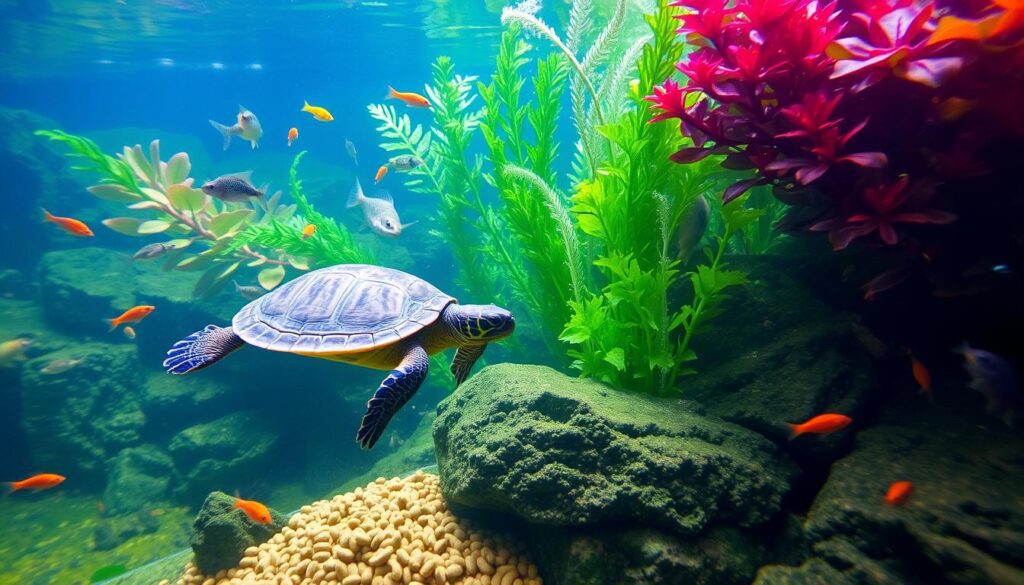
| Food Item | Recommended Portion |
|---|---|
| Commercial Turtle Pellets | 25% of the diet |
| Leafy Greens (Collard Greens, Kale, Bok Choy) | Significant portion of the diet |
| Aquatic Plants (Anacharis, Water Hyacinth) | Occasional snacks |
| Vegetables (Carrots, Squash, Green Beans) | Shredded for smaller turtles |
| Live Prey (Earthworms, Crickets, Snails, Shrimp) | Beneficial for exercise and enrichment |
| Fruits (Bananas, Berries, Melons) | Occasional treats in small amounts |
| Cooked Meat (Chicken, Beef) | Avoid feeding as they can cause health issues |
| Processed Foods (Hotdogs, Lunch Meat, Bread) | Never feed to turtles |
By following these turtle diet and feeding turtles guidelines, you can ensure your red-eared slider receives a balanced omnivorous diet. This diet supports their health and well-being.
Common Health Issues and Prevention
Keeping a pet red-eared slider healthy is key. They can get sick with shell rot, respiratory infections, and vitamin deficiencies. Knowing the signs and taking steps to prevent these can help your turtle stay well.
Shell Problems
Shell rot is a big problem for these turtles. It’s a fungal or bacterial infection that can harm the shell. Look for green patches, soft spots, or color changes. Quick treatment, like salt baths and gentle scrubbing, is needed to fix it.
Respiratory Infections
Red-eared sliders can also get respiratory infections, like pneumonia. This can happen if they don’t get enough vitamin A. Watch for mucus, nasal discharge, and breathing problems. Antibiotics and the right environment can help fix it.
Vitamin Deficiencies
Vitamin A is very important for these turtles. Without enough, they can get skin problems, lose their appetite, and even have kidney failure. A good diet and UVB lighting are key to preventing this.
Regular vet visits, clean water, and quick action when they’re sick are vital. By being careful and proactive, you can keep your turtle healthy and happy for a long time.
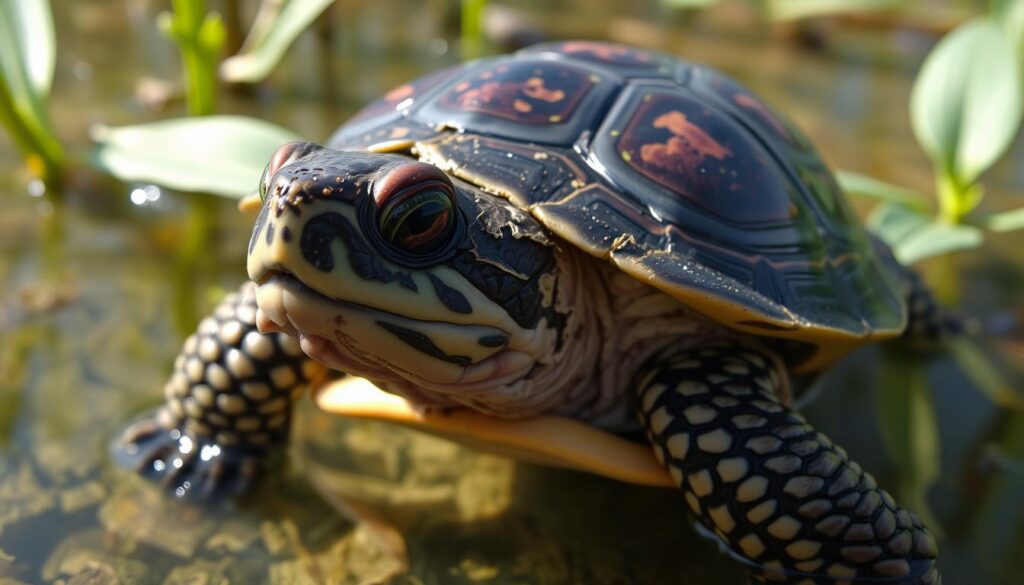
Breeding and Reproduction
The red-eared slider, a favorite pet turtle, grows up between 3 to 5 years old. They show clear signs of being male or female. Males have longer front claws and tails than females.
Breeding time for these turtles is in spring and fall. Females can lay 2 to 25 eggs from April to July. They need a special place to lay eggs to avoid health problems.
But, it’s important to note that breeding red-eared sliders can lead to too many in the pet trade.
To help with breeding and reproduction, consider these important points:
- Give the female a good place to lay her eggs.
- Keep the right temperature and humidity for egg incubation.
- Watch the eggs closely to prevent infections or moisture issues.
Understanding the breeding and reproduction needs of red-eared sliders helps pet owners. It ensures they care for these amazing reptiles responsibly.
Handling and Socialization Tips
Caring for a red-eared slider turtle needs careful handling and socialization. These reptiles are delicate and should be treated gently. Understanding their natural behaviors and using safe handling techniques helps build a strong bond with your pet.
Safe Handling Practices
When handling a red-eared slider, support its body and shell with both hands. Never grab the turtle by the tail or limbs, as it can cause stress and injury. Always wash your hands before and after handling to prevent Salmonella bacteria.
Building Trust
Red-eared sliders raised from a young age may become more social. But, it’s important not to handle them too much, as it can stress them. Observe their behavior to understand their comfort level and preferences. Slowly introduce yourself and let the turtle get used to your presence. With patience and gentle interactions, you can build a trusting relationship with your pet turtle.
By following these tips, you can create a safe and enriching environment for your red-eared slider. Remember, these turtles are unique individuals with their own personalities. It’s your responsibility as a pet owner to ensure their well-being and comfort.
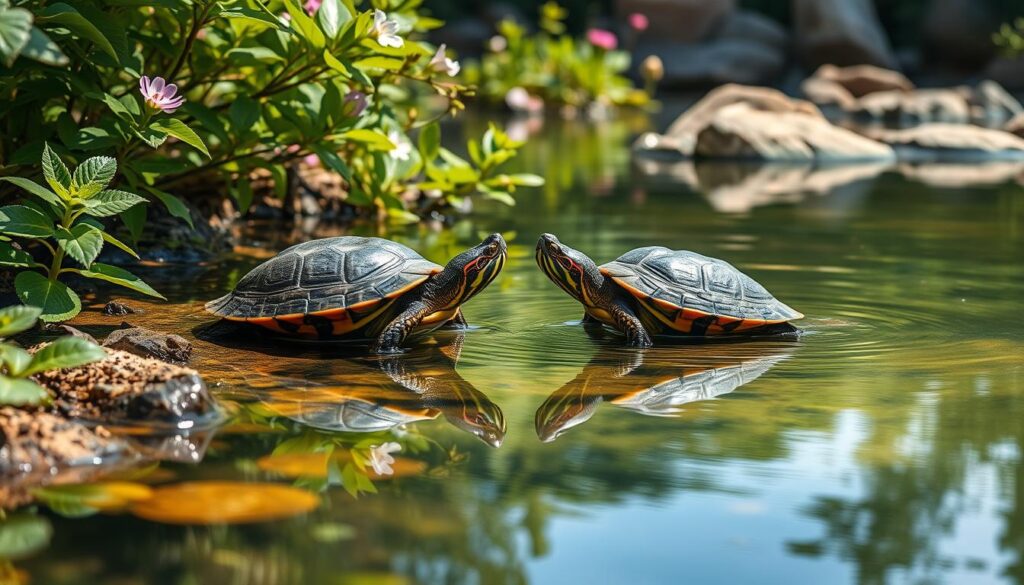
Tank Decoration and Enrichment
Keeping red-eared sliders happy and healthy means giving them a fun and engaging home. Adding decorations and toys can make their tank a lively place. It helps them stay active and sharp.
Turtle enrichment is key. Include hiding spots, floating objects, and various textures. Plants like water hyacinth and water lettuce are not just pretty. They’re also good for your turtle to eat. Some turtles even like to play with floating toys like ping pong balls.
Changing the layout of your tank’s aquarium decor often is a good idea. It keeps your turtle interested and stops them from getting bored.
| Substrate Type | Recommendations |
|---|---|
| Gravel and Pebbles | Provide at least 2″ of substrate for a pleasing aesthetic and to fulfill the turtle’s digging behavior. But, be careful as eating it might need surgery. |
| Fine-Particle Substrates | These can make the water cloudy because of the turtle’s actions and can also mess with the filter. |
| Rocks | Choose rocks carefully for décor because sharp edges can hurt a turtle’s shell. |
Adding turtle toys and interactive things can really boost your red-eared slider’s happiness. From floating toys to live prey, different things can keep them interested and active.
By making their tank both beautiful and stimulating, you can make sure your red-eared slider is happy and healthy. They’ll have a great life in captivity.
Conclusion
Red-eared sliders can be great pets if you give them the right care. They need a lot of space, special equipment, and regular upkeep. Before getting a turtle, it’s important to do your research and be ready for the long-term commitment.
Instead of buying turtles from pet stores, think about adopting from rescues. This helps solve the problem of too many turtles. By choosing to adopt, you can enjoy having a turtle as a pet while also helping native turtles.
Red-eared sliders can be wonderful pets if you’re willing to put in the effort. They need the right care and a safe environment. With the right knowledge and commitment, you can give your turtle a happy and responsible home.
FAQ
What is a red-eared slider?
Red-eared sliders are freshwater turtles from the United States. They are semi-aquatic and have a red stripe behind each eye. They are also popular pets.
How big do red-eared sliders get?
They can grow up to 12 inches long. In captivity, they can live 20-30 years or more.
What kind of habitat do red-eared sliders need?
They need a large aquarium with proper lighting and heating. They also need a good filtration system. A diverse diet is important. They need both water and dry areas to thrive.
What is the best way to set up a red-eared slider tank?
A tank over 100 gallons is best for adults. It should have logs, rocks, and plants. This helps mimic their natural habitat.
What kind of lighting and heating do red-eared sliders require?
They need UVB lighting and a basking area at 90-95°F. Use submersible or under-tank heaters to keep the water at 72-76°F.
What should I feed a red-eared slider?
They are omnivores. Feed them commercial turtle pellets, fresh veggies, and occasional protein like small fish or insects. A balanced diet is key to their health.
What are common health issues in red-eared sliders?
Shell rot, respiratory infections, and vitamin A deficiency are common. A good diet, UVB exposure, and clean water can help prevent these issues.
How do I handle a red-eared slider safely?
Handle them gently, supporting their body and shell. Wash your hands before and after handling. Avoid too much handling to prevent stress.
Can red-eared sliders be bred in captivity?
Yes, they can be bred in captivity. But be cautious as it can lead to overpopulation. Make sure to provide a nesting area for females.


